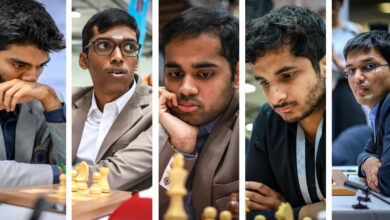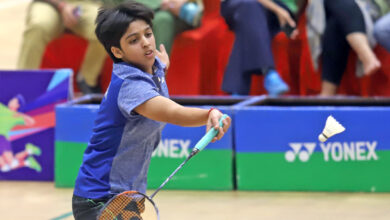Border-Gavaskar Trophy: Trial spin awaits Australia

Every day before the nets session, Marnus Labuschagne would stand beside the centre pitch and gaze meditatively at the 22-yard brown patch. He would then shift to the side and shadow bat for a few minutes before picking his kit and strolling to the nets, where he would manufacture a rough with his studs and ask the spinners in the nets to pound the abrade region. After every ball, he would inquire his colleagues on his alignment, his knee-flex, head-position and all such-like little details that have made him a batting colossus in the last two years.
Last year, to perfect his spin-game in the subcontinent before the odyssey to Pakan and Sri Lanka, he invented what he calls a spin carpet, a rubber mat sprinkled with taped aluminium scraps and metal sheets, from where the ball would bounce, leap or skid depending on where and how the ball lands. “I thought, ‘well, what’s the best way I can recreate spin?’ … you can’t really predict what it’s doing so you have to come up with a plan and a method,” he tweeted.
Like Labuschagne, his colleagues too have elaborately prepared to deal with the vicissitudes of subcontinental turners, from preparing on scuffed-up surfaces with low bounce, practising Asia-specific strokes, like the sweeps, using the feet more proactively to meet them on the pitch, art of manoeuvring singles and twos, using the depth of the crease smartly, analysing the bowlers, watching and rewatching them, studying fields and fielders, facing look-alike spinners to get used to the trajectories and lengths, and tuning their muscle-memory. Or rather, they have come planned and prepared to conquer the twirly-men of the sub-continent, buoyed no less their success in Pakan and Sri Lanka as well.
Nagpur 📍
ARE YOU READY❓#TeamIndia | #INDvAUS pic.twitter.com/JgRsLTZFIp
— BCCI (@BCCI) February 8, 2023
Planning and preparation are requisites in taming the spinners, because spin bowling varies in different parts of the world. In Australia, the spinners purchase more bounce and hence batsmen could trust the bounce and play their shots. On wearing surfaces, the ball could leap off a spot or scud along the ground. But not every ball is prone to such fits. The scoring areas are different too; in the sub-continent a lot more runs are scored behind the stumps, through late cuts, sweeps and deflections, whereas in Australia the run-scoring outlets are often in front of the stumps. Worsening their occupation, the nature of turners vary, not just venue-specific but from day-to-day and session-to-session. The turn could be slow and low, or sharp and snappy, the bounce could be true or fickle. A pitch could suddenly slumber and then in the twitch of an eye wake up and emit fire like a hungry dragon.
So the finest overseas players of spin are those that have not only planned and practised but those with a streak of fearlessness and flexibility of mind. Instructive it is to revisit Kevin Pietersen’s 186 in Mumbai, arguably the most destructive knock in the country an overseas batsmen. It was the perfect blend of the aforementioned qualities. Pietersen had come planned and prepared, which all competent batsmen at this level do, but the soul of the knock was how he revised his plans and found a way to belt runs.
Picture Perfect 📸 🏆
CAN. NOT. WAIT ⌛️#TeamIndia | #INDvAUS | @mastercardindia pic.twitter.com/OqvopNKbHd
— BCCI (@BCCI) February 8, 2023
Between the Ahmedabad (17 and 2) and Mumbai Tests he analysed the reasons for his failings and realised that he was not trusting his defensive technique, which is equally important to succeed in these shores. But when in Mumbai, where it turned and bounced, as opposed to Ahmedabad where the bounce was low and turn slow, he realised that he could not survive just defending. He counter-attacked in bursts, primarily employing the sweeps, some hit firmly, some dabbed fine, some of the reverse variety. But at the core of his success was that he did not cripple his mind with doubts when the odd ones beat him or when he edged. He was as flexible with his strategies as he was with his body.
Not all batsmen that have succeeded in the sub-continent were Pietersen-like in approach. There are those that grafted and grounded runs, like Alastair Cook, but most of the successful ones this century were stroke-makers like Matthew Hayden, the oft-forgotten Hashim Amla, Michael Clarke, Damyn Martyn and Joe Root. And not all of them were exceptional sweepers — Clarke for instance — though the sweep has been the most trusted shot for many. Clarke needn’t because he had nimble feet to glide down the surface. So had Martyn. Root has all the ammo—sweep, quick feet, soft hands, defensive sturdiness, ability to use the depth of the crease and a deep understanding of a spinners’ mind.
Later, India’s skipper Rohit Sharma would detail on approaching spinners on turners: “Everyone has their own method, some like to go straight over the head of the bowler. Some sweep, some reverse sweep, things like that. You have to rotate strike, see what are the methods you can score runs off, you have to think on your feet, because bowlers and captains are smart and they keep changing plans and strategies.”
Permutation-combination for the #INDvAUS Test series opener❓#TeamIndia | @ImRo45 pic.twitter.com/njzAzGLNEp
— BCCI (@BCCI) February 8, 2023
You also have to choose what shots to play and what not to, against which bowler and when. Like how Pietersen resed from attempting anything outrageous against Ojha, a tormenter, in the first half of the innings, though in the latter half he did demolish how. Or how Sunil Gavaskar drove Pakan left-arm spinner Iqbal Qasim only when he strayed into middle and leg and with a full face. When you look at some of the sub-continental batsmen of the past, like VVS Laxman, even when he played against the turn, the ball was met with a full face, before the rubbery wrs kick into action and coax the ball to where his mind whims.
So the real spin test for the Australians would only begin on Thursday, where all that they have imbibed in theory and nets would be put to test, and how effective they are, could decide the outcome of the series. Labuschagne would tell you how difficult it is. In Asia, he averages just 33.33 in seven Tests, a steep dip from his overall average of 59.43, eking out a lone hundred, though that arrived on a Galle minefield. But even after the hundred, he wouldn’t say that he has vanquished the sub-continent spin demons, because the demons keep spooking back.






